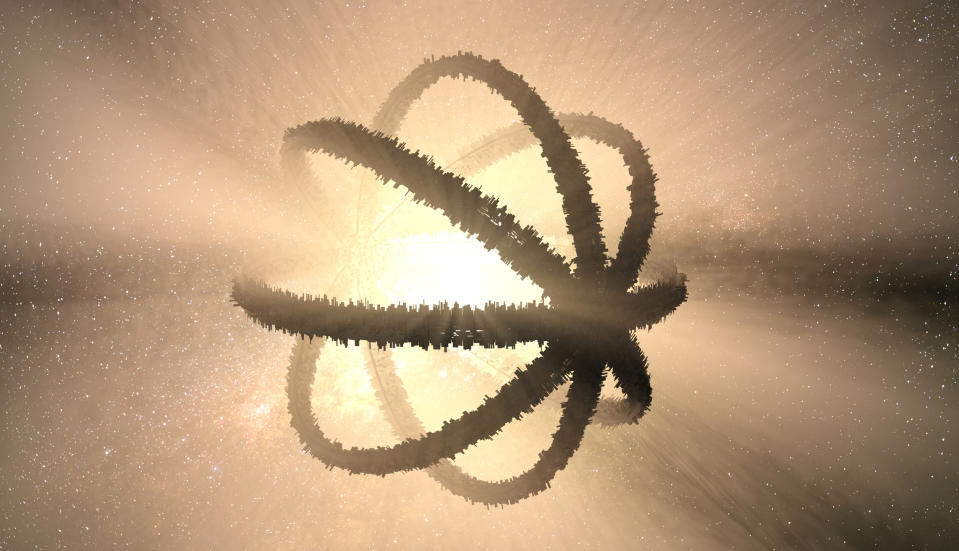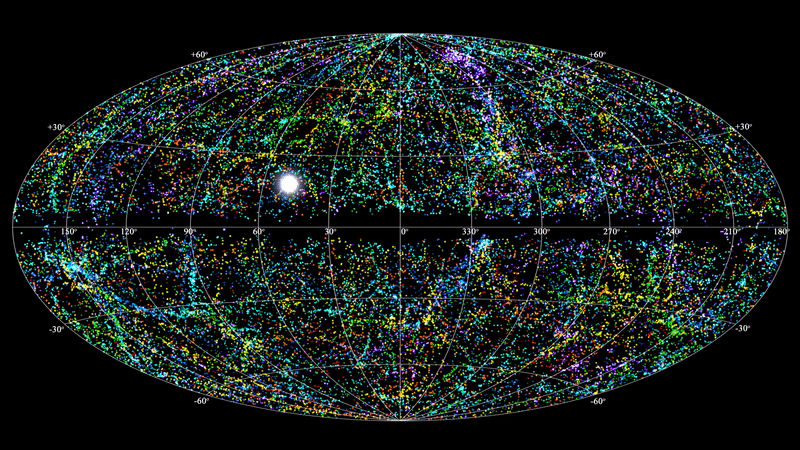In the search for alien life, should we be looking for artificial intelligence?

Is biological life common in the universe, or should we be looking for artificial, robotic intelligence in the search for alien life?
An increasing number of scientists suspect that if we ever do make contact with alien life, we will be communicating with a computer.
This thinking revolves around an event called the singularity. This term, borrowed from mathematics, signifies a point where our knowledge of math and physics breaks down and we can no longer accurately characterize what we're trying to describe. A black hole singularity is a good example of this.
Related: Could AI find alien life faster than humans, and would it tell us?
In computer science and technology, the singularity describes the moment when artificial intelligence develops so fast that it results in a superintelligence — an artificial general intelligence, as opposed to the very specific machine-learning algorithms we have today — that experiences runaway growth in computing power and intellectual ability. This superintelligence would grow so far ahead of us, so quickly, that we would lose the ability to understand or explain it.
Computer scientists have been speculating that the singularity could come soon; most predictions seem to agree on the period between 2030 and 2045. What happens beyond the singularity is anyone's guess.
Related stories:
—If aliens have visited the solar system, here's how to find clues they left
—Repeated signals from the center of the Milky Way could be aliens saying hello, new study claims
—To find intelligent alien life, humans may need to start thinking like an extraterrestrial
There's no guarantee that the singularity will come to pass; many academics remain skeptical. However, if it does, the timescales would be remarkable, given that it is predicted to occur just 250 years after the Industrial Revolution, 130 to 140 years after the Wright brothers' first powered flight, a century after the atom was first split and 50 years after the invention of the World Wide Web. If we are a typical civilization in the galaxy, the singularity would seem to happen early in the life of a technological species.
Now, consider the age of the universe: 13.8 billion years. Assuming that life has been able, in theory, to develop and evolve for the vast majority of that history, alien species could be billions of years older than our solar system and many billions of years older than Homo sapiens. They would have had plenty of time to pass through the technological singularity, which is why so many researchers studying the search for extraterrestrial intelligence (SETI) are convinced that technological aliens will be artificial intelligences.
"This is very much at the vanguard of thinking in some sections of the SETI community," Eamonn Kerins, an astrophysicist and SETI researcher at the Jodrell Bank Centre for Astrophysics at the University of Manchester in the U.K., told Space.com. "We ourselves are very close to realizing artificial general intelligence (AGI), and there's an expectation that once you reach that point, it can then accelerate away at a very fast rate and quickly outstrip ourselves in intelligence."
Searching for superintelligences

Suppose alien life was some form of superintelligence that had gone way past the singularity. What would it mean for SETI?
SETI focuses on searching for radio signals, the same kind that humans transmit. There are still very good reasons for searching the radio spectrum: Radio waves can permeate the Milky Way galaxy, they're a relatively simple means of signaling, and aliens would suspect that our astronomers were already studying the universe in radio waves and would therefore be more likely to spot a radio signal.
A superintelligence billions of years older than us, however, might have long since moved past radio and might not even care enough to attempt to contact primitive life-forms on Earth.
Beyond looking for signals, recent SETI efforts have been considering the broader concept of technosignatures — evidence for extraterrestrial technology or engineering — possibly on an enormous scale for it to be noticeable to us. This might be one way of detecting an artificial superintelligence since the search for technosignatures is agnostic about why the aliens are doing what they're doing. Beyond the singularity, such reasons might be difficult for us to discern.
"Some of this [discussion about superintelligences] almost doesn't matter from the point of view of doing the search, if you build a good enough anomaly detector," Steve Croft, a radio astronomer who works on the Breakthrough Listen project for the Berkeley SETI Research Center at the University of California, Berkeley, said in an interview with Space.com. "We can figure out what they're up to afterwards — we may never comprehend what they're up to."
All that would matter is that we could potentially detect these intelligent life-forms' activities, even if we don't fully understand what they're doing. In some cases, though, we might understand.
A superintelligence would need a lot of energy to facilitate the computations of its CPU. In 1964, Soviet astrophysicist Nikolai Kardashev proposed what would become known as the Kardashev scale, in which increasingly technologically developed civilizations harness the total energy of first a planet (Level I), then a star (Level II) and then an entire galaxy (Level III).
In principle, the latter two levels would be achievable via Dyson swarms of solar-energy collectors around a civilization's home star, and then around every star and black hole in their galaxy. According to the Kardashev scale, a Type II civilization could harness 4 x 10^26 watts; a Type III civilization could reach 4 x 10^37 watts.
A superintelligence might even opt to live inside a Dyson swarm — for example, in a "Matrioshka brain," a series of nested shells of Dyson swarms in which the innermost shell absorbs sunlight, uses the energy for processing and then emits the residual heat energy for the next shell to pick up, and so on.
What do superintelligences do in their spare time?

What would a superintelligence do with all that energy? "Maybe they smash neutron stars together for fun and those are the fast radio bursts!" Croft said, only half-jokingly. "If you do have command of ridiculous amounts of energy, if you've achieved a Kardashev Type II or III level, then what might you do with your spare time? One thing we've seen through human societies over millennia is art, and it drives a lot of our endeavors, creating beautiful things, and I wonder whether a superintelligence might make art and whether that's something we could spot."
Spotting alien art might not be so easy; art is cultural, so we would not know what is beautiful to them. However, the scale of the potential art projects we could detect might make life easier. A superintelligence might push stars around, for example. One theoretical way of doing this is via a Shkadov thruster, which is essentially a giant concave mirror facing a star at a distance where the gravitational attraction that the mirror feels from the star is balanced by the stellar wind trying to push the mirror outward. The mirror would reflect the stellar wind and the star's own light back toward the star. And because photons and particles can carry momentum, the reflected radiation would push the star in the opposite direction. Over millions of years, it could, in theory, move the star many light-years.
If an alien superintelligence has an artistic leaning, it may wish to assemble geometric shapes out of stars, such as a Klemperer rosette. This is a gravitationally stable system of six objects — in this case, stars — perhaps alternating in mass between large and small, all moving around a common point on the same orbit. Such a star system could not form naturally, and if we found one, it would be evidence for a powerful extraterrestrial intelligence. An alternative concept would be to place all of the planets in a system on the same orbit around their star; a recent study showed how it might be possible to fit 24 planets on the same orbit without them colliding.
However, all of these are brute-force projects. Superintelligence may be more focused on the loftier goal of just thinking, or running virtual reality programs. Processing information requires a lot of energy, and the more a superintelligence thinks, the more energy it will require. And the less ambient heat there is, the more efficiently the computations run.
The interior of the Milky Way galaxy is a warm place, so superintelligences might relocate to the outskirts of the galaxy, where the ambient temperature drops, thus allowing more efficient information processing. Some researchers have even proposed that superintelligences might go into hibernation for tens of billions of years while the universe around them cools to just a fraction of a degree above absolute zero, which would permit more efficient computations. (Currently, the universe — or, more specifically, the cosmic microwave background, the leftover radiation from the Big Bang — is 2.73 kelvins above absolute zero.).
What would they be thinking and calculating? That's not a question we can answer, but we don't need to. All we have to do is find evidence for their presence — whether in a Dyson swarm, a Shkadov thruster, a Klemperer rosette or activity on the edge of the galaxy. And perhaps, if our own AIs arrive at the singularity too, that could give us some insight into what the great intelligences of the universe spend their time doing.
Follow Keith Cooper on Twitter @21stCenturySETI. Follow us on Twitter @Spacedotcom and on Facebook.

